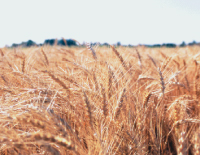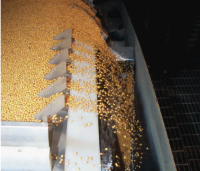
News
Future of farming dealing with many issues
Success based on adapting, finding value.
September 30, 2008 By Ralph Pearce
Success based on adapting, finding value.
Since the late 1990s, growers and producers have been hearing much the
same thing: success in agriculture is all about change and accepting
new realities. In a current economy where commodity prices are at an
all-time high, many involved in farming might believe there is little
reason for concern. Short supply and increasing worldwide demand are
likely to keep prices on the upside through
to 2009.
Is there a need to change and accept new concepts? There is, if
long-term sustainability is a goal. That according to a number of
conferences and workshops that have taken place since early 2006. Some
have focussed on farm size and the need to specialize in higher-value
crops. Others have studied the food value chain in Canada and other
countries. Still others have acknowledged the existence of untapped
market potential in previously unexplored places. The key in all of
these scenarios is an open minded willingness to at least explore the
possibilities in order to succeed.
 |
| Improved relations with millers and bakers have spelled premiums for western Canada wheat growers, whose product is used in Warburton Breads in the UK. |

|
| Getting to know more about the food value chain, including processing, will help growers discover higher returns through more diverse markets and more lucrative end users. |
Value – what is in a name?
Contrary to the success that high commodity prices can offer
short-term, Martin Gooch maintains that now is the best time to work
towards creating a more sustainable agri-food industry through
improving relationships within the food value chain. As senior research
associate with the George Morris Centre in Guelph, Gooch cites the
examples of Warburton Breads and Tesco Grocers, both from the UK, as
two corporations that have succeeded in building value in the minds of
the customer. Tesco Grocers has become a leader in terms of its ability
to tailor goods and services to the specific needs and demands of each
consumer. The chain does this through a shopping card which gathers
information on the individual’s purchases, including favourite brands,
premium versus discount products and lifestyle choices (organic versus
conventional). With the kind of information Tesco obtains from those
cards, it is conceivable that growers could take advantage of demands
for specific traits or characteristics made by consumers.Retail chains
in North America have attempted this same approach, including Costco and Zellers. “But
they don’t have the ability to drill down and mine that information for
its full value,” says Gooch. The other impediment is the link between
value and least cost, another shortcoming of North American consumer
habits. And creating that link of information back to the grower is the
trend Canadian agriculture should recognize and follow.
As for Warburton Breads, the UK company retails a variety of different
types of bread, all in the $3.00 (C$) range, yet all reportedly, are
hard to keep on the shelf. That is because the value that a customer
derives from the bread is greater than its price. It is certainly not a
tangible, scientific guideline, but their sales are certainly concrete.
The same principle applies to Heinz ketchup or Kraft peanut butter: the
value of these premium products goes beyond mere dollars and cents
because of the satisfaction they create, either on the basis of
flavour, food safety or quality, or perception, where the consumer
‘feels’ better for buying it. That feeling cannot be discounted; it may
even be more tangible than price.
The best part of the Warburton success story is that most of the wheat
used in baking their specialty breads comes from western Canada where
growers receive a premium for their management practices and production
excellence.
Gooch agrees that value has a place in the hearts and minds of the
consumer that goes beyond price, provided the product has meaning to
the consumer. “Value is in the eye of the consumer, not in the eye of
the producer,” he states bluntly. “Too often, agriculture follows a
business model based on tradition, not on commercial structures. If
you’re worried about growing commodity corn, don’t grow commodity corn;
grow corn for a specific market, and also provide customer service
because value goes beyond that physical product
these days.”
From Gooch’s point of view, the key is to allow the individual the
freedom to change, be creative and innovative. “There’s far too much
focus on looking at lifting an industry up rather than giving the
innovators the free reign to innovate and let those benefits trickle
down,” he says, adding that regulatory guidelines in Canada are too
restrictive. Instead, the power comes from the individual and from
there, the industry benefits. “We try to take it the other way, saying,
‘Let’s develop a strong industry and then we can develop strong
businesses’, which just won’t work. You can’t hold back the leaders
while you wait for the followers to catch-up.”
Recognizing opportunity for what it is, not how it looks
Another fact of life in the modern world that producers need to
understand is the changing face of Canada. Early in 2008, the Toronto
Star published a statistical analysis of the impact of immigration on
language in the Greater Toronto Area
(www3.thestar.com/static/PDF/20071230_ID06.pdf). The elaborate maps
provided a stunning glimpse of just how many languages are now ‘at
home’ in the GTA. It is little wonder that the United Nations has
called Toronto the world’s most ethnically diverse city.
Where Italian, Portuguese and Polish have been historically dominant
tongues other than English in parts of the GTA, Chinese, Cantonese and
Punjabi are now three of the four most-frequently spoken languages aside from English in the provincial
capital (the other is Italian). Yet it should not be viewed as a threat
to convention, but an incredible opportunity for food processors and
manufacturers to cater to the demands placed on the agri-food industry
by such a diverse ethnic base. And growers and producers are at the
forefront of this wave of opportunity, provided they recognize it for
exactly what it is, and not lose sight of it because of reluctance and
cultural uncertainty.
For Dr. Vincent Amanor-Boadu, the cultural void is one that has gone
unnoticed by many primary producers. A former director of research at
the George Morris Centre, and now a professor of agricultural economics with Kansas State University,
Amanor-Boadu believes the only thing holding back growers or anybody in
business is the ability and willingness to see opportunities when it
presents itself. In 2006, he led a group of American growers to Ghana.
On the road from the airport, they saw a GM Hummer among other high
priced vehicles. The astonished growers asked ‘How can they afford a
Hummer?’ “And my response to them was, ‘No, the question you should be
asking is, How could I sell them more?’,” explains Amanor-Boadu. “The
whole history of agriculture has been driven by the notion of being a
follower. Bob Hunsberger (a board member with the George Morris Centre)
put it nicely when he said that agriculture is the only industry where
we take highly differentiated inputs and yield very homogenous,
undifferentiated outputs.”
Like Gooch, Amanor-Boadu believes an adjustment to the definition of
‘value’ is in order. At the 2006 Outlook Conference in Toronto, he
praised a presentation by the president of Cambridge based Al Hafiz
Halal Meat, for successfully restructuring their facility to cater to
the large Muslim population in the GTA. The market emerged simply by
seeing and seizing the opportunity. The same is true of Toronto’s gay
community, says Amanor-Boadu. It is a vast and untapped market that is
willing to pay premiums for products they value. “I frame it from the
perspective of profit,” he explains, noting that approval of a person
or their lifestyle should never enter into the sales and purchasing
equation of any product.
The bottom line is, people have the right to choose but choice is not free. “When our personal values and perceptions influence our willingness to seize opportunities, we must know how much we are paying for those perceptions,” says Amanor-Boadu.
Which is important: size or value?
In 2006, Dr. David Sparling made several presentations on the future of
farming, particularly with regards to the size of farm operations. As
the executive director for the Institute of Agri-Food Policy Innovation
in Guelph, his research concluded that producers have a better chance
of deriving sufficient income from farms that are either large enough
to generate $250,000 in annual revenue, or are managed well enough to
derive higher revenues from specialty crops. Although he recognizes the
benefits of higher commodity prices present day, his recommendations
call for a shift in mind-sets as they pertain to research and
development at the farm and processing levels. He acknowledges that
there are some very good commodity producers across Canada, that they
do well in terms of productivity, managing inputs, costs and marketing.
“If I can do all of those things better than the people around me, I
should be able to compete,” reasons Sparling. “But the challenge is
that I not only have to do it better than the people around me, I have
to do it better than the people in Brazil, and suddenly, their cost
structure is dramatically different from ours.”
When he examines where agriculture is going, again, the term ‘value’
begins to creep into the conversation. Value is defined differently by
different people. “To me, the next big shift for agriculture is going
to be trying to A) focus on value and then B) asking, ‘Who do I have to
work with to get that value?’” poses Sparling. One of the failings in
Canada is that growers are not gifted at networking. Producers can
produce $5.0 to $10 million of product yet not attract attention from
investors. “But maybe they’d capture a lot more attention if there were
half a dozen producers together who are large, and say, ‘We’re going
into business together and we’re going to crack that market’.”
The issue at that point may be that together, they have the resources
and financial clout to build those relationships and get noticed by
investors. This, notes Sparling, is where organizations like the
Ontario Federation of Agri-culture can be of tremendous value, acting
as an advocate on behalf of these fledgling ventures. “When you look
ahead, it’s going to be a dramatically different world,” he says.
“Growers cannot function totally independent. It’s extremely important
for us to ask, ‘Who are we going to work with and what are we going to try to accomplish together that we can’t accomplish alone?’”